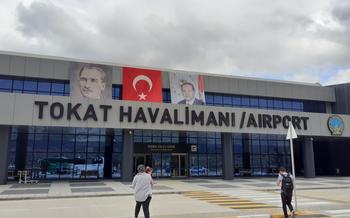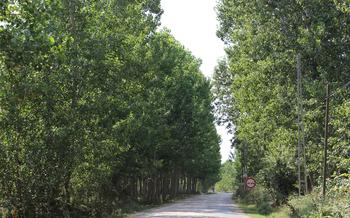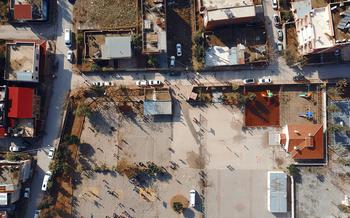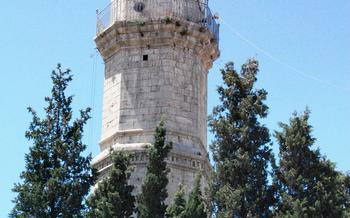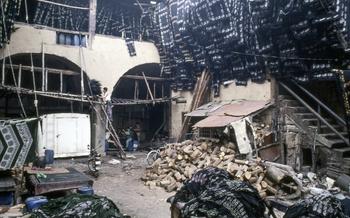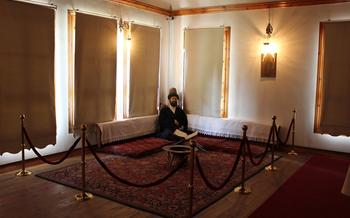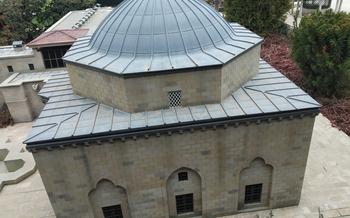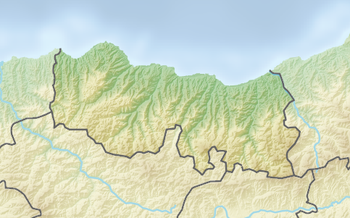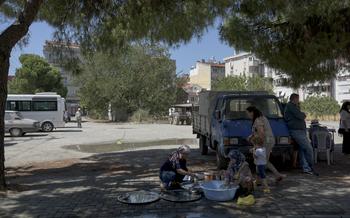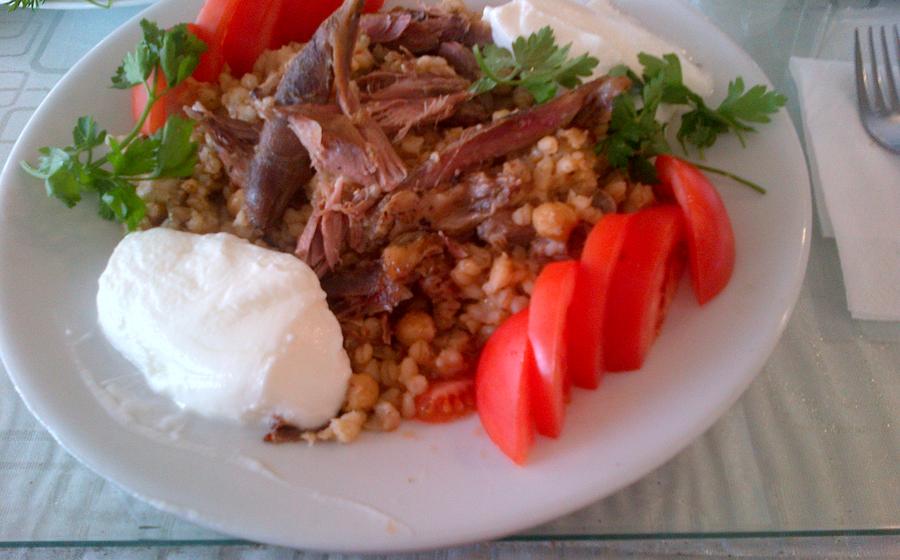
Cami Cedid (New Mosque)
- The Cami Cedid (New Mosque), a Historical Marvel
- Location and Accessibility
- Exploring the Mosque's Interior
- The Courtyard and Ablution Fountain
- Women's Section and Prayer Area
- Significance in Islamic Architecture
- The Role of the Mosque in the Community
- Local Traditions and Customs
- Photography and Videography Guidelines
- Nearby Attractions and Landmarks
- Suggested Itineraries
- Food and Accommodation Options
- Language and Communication
- Insider Tip:
- Insider Tip: Unveiling the Hidden Treasures of the Cami Cedid
The Cami Cedid (New Mosque), a Historical Marvel
The Cami Cedid, also known as the New Mosque, stands as a testament to the rich history and architectural legacy of Tokat, Turkey. Constructed during the Ottoman era in the 16th century, this magnificent mosque holds a significant place in the city's cultural and religious landscape. The mosque, built by the renowned architect Mimar Sinan, showcases the grandeur and elegance of Ottoman architecture, blending intricate tilework, calligraphy, and ornamental designs.
As a functioning mosque, the Cami Cedid serves as a spiritual center for the local Muslim community, facilitating daily prayers and religious gatherings. Its spacious prayer hall, adorned with stunning chandeliers and carpeted floors, exudes an aura of tranquility and devotion. The mosque's courtyard, featuring an ablution fountain for ritual cleansing, adds to its serene ambiance.
The Cami Cedid has undergone meticulous preservation and restoration efforts over the years to maintain its architectural integrity and historical significance. This ongoing dedication ensures that future generations can continue to appreciate the mosque's beauty and its role in shaping the cultural fabric of Tokat.
Location and Accessibility
The Cami Cedid (New Mosque) is conveniently located in the heart of Tokat, Turkey, making it easily accessible for visitors. The exact address is Cami Cedid Mahallesi, Yeni Cami Sokak. To reach the mosque, you can either take public transportation or drive your own vehicle. Public transportation options include buses and taxis that stop nearby, while for those driving, there is ample parking space available in the vicinity. It's important to note that the mosque is wheelchair accessible, ensuring that all visitors can comfortably explore its premises.
When visiting the Cami Cedid, you'll find yourself surrounded by several other notable attractions and landmarks. The Tokat Castle, with its rich history and stunning views, is just a short walk away. Additionally, the Sulusaray Palace, famous for its scenic surroundings, is also within easy reach. For those interested in delving deeper into the region's history and culture, the Tokat Museum and the Gökmedrese Theological School are both must-visit destinations located nearby.
Exploring the Mosque's Interior
Venture into the heart of the Cami Cedid and be awestruck by the grandeur of its main prayer hall. Its vast space, adorned with intricate tilework, calligraphy, and ornamentation, creates an atmosphere of awe and serenity. The mihrab, or prayer niche, faces Mecca and is meticulously crafted with intricate designs that draw the eye. The minbar, or pulpit, stands tall, inviting visitors to sit and contemplate the teachings of the Quran.
The mosque's stained glass windows, with their vibrant hues, allow natural light to filter through, casting a warm glow on the interior. The interplay of light and shadow adds to the mosque's ethereal ambiance, creating a sense of reverence and spirituality. Marvel at the breathtaking beauty of the mosque's interior and soak in the tranquility that surrounds you.
The Courtyard and Ablution Fountain
The courtyard of the Cami Cedid, a serene and inviting space, serves as a gathering place for worshippers and visitors alike. Embellished with intricate tilework and lush gardens, it offers a tranquil respite from the bustling city streets. The courtyard's centerpiece is the ablution fountain, an essential element of Islamic architecture that facilitates ritual cleansing before prayer. With its elegant design and intricate carvings, the fountain adds to the mosque's overall aesthetic appeal. Surrounding the courtyard are well-manicured gardens, providing a picturesque backdrop for contemplation and relaxation.
Women's Section and Prayer Area
In keeping with Islamic traditions, the Cami Cedid features a separate prayer area for women. This section is located on the upper level of the mosque and offers a serene and tranquil space for female worshippers. The women's prayer area is beautifully decorated with intricate tilework, calligraphy, and stained-glass windows, creating an atmosphere of spirituality and reverence.
Cultural significance and customs related to women's prayer in Islam emphasize modesty, privacy, and respect. Female visitors are expected to dress conservatively, covering their hair and body appropriately. It is customary for women to perform ablution before prayer, using the designated ablution fountain in the courtyard.
Etiquette and dress code for female visitors are essential to maintaining the sanctity of the mosque. Visitors should be mindful of their behavior, avoiding loud conversations or disruptive actions. Respecting local customs and traditions is crucial for creating a harmonious and welcoming environment for all worshippers.
The mosque provides various facilities and amenities for women, including prayer mats, Qur'ans, and a comfortable seating area. These amenities ensure that female visitors have a convenient and fulfilling prayer experience.
Significance in Islamic Architecture
The Cami Cedid stands out for its unique architectural features that set it apart from other mosques in Turkey. Its design blends elements of Ottoman and Seljuk architectural styles, creating a harmonious fusion of different eras. The mosque's grand dome, supported by elegant arches, is a testament to the engineering prowess of its builders. The intricate tilework, calligraphy, and ornamentation adorning the interior walls and mihrab showcase the artistry and craftsmanship of the period. Compared to other significant mosques in Turkey, such as the Hagia Sophia or the Süleymaniye Mosque, the Cami Cedid may not be as grand in scale, but it holds its own charm and significance in the realm of Islamic architecture. The mosque's historical context and evolution reflect the changing political and cultural landscape of Turkey, making it a valuable example of the country's rich architectural heritage.
The Role of the Mosque in the Community
The Cami Cedid serves as a pivotal hub for the local Muslim community, fostering a profound sense of belonging and interconnectedness. Its primary function as a place of worship is complemented by a multitude of religious ceremonies, festivals, and events that bring the community together in celebration and spiritual reflection. These gatherings not only strengthen the bonds of faith but also contribute to the preservation and transmission of Islamic traditions and values.
Beyond its religious significance, the mosque plays a crucial role in the social and educational fabric of the community. It serves as a venue for various social activities, fostering a sense of unity and camaraderie among its members. Educational programs and classes are also organized to impart Islamic teachings, promote literacy, and nurture the spiritual development of the younger generation. By fulfilling these diverse roles, the Cami Cedid plays an indispensable role in shaping the cultural and religious identity of the local community.
Local Traditions and Customs
The Cami Cedid, like many other mosques in Turkey, is a place where local traditions and customs are deeply intertwined with religious practices. Visitors are expected to dress and behave respectfully, adhering to certain cultural norms. When entering the mosque, it is customary to remove one's shoes and place them neatly on the designated shelves. Women are expected to cover their heads with a scarf or headscarf as a sign of modesty. It is considered disrespectful to point one's feet towards the qibla, the direction of prayer towards Mecca.
When it comes to prayer, there are specific customs and etiquette that visitors should be aware of. During congregational prayers, men and women pray in separate sections of the mosque. Women typically occupy the upper level or a designated area at the back of the main prayer hall. It is important to maintain silence and avoid disturbing those who are engaged in prayer. Visitors are welcome to observe the prayer rituals from a respectful distance, but it is considered inappropriate to take photographs or videos during prayer times.
By respecting local traditions and customs, visitors can demonstrate their understanding and appreciation of the cultural significance of the Cami Cedid and contribute to a harmonious and welcoming atmosphere.
Photography and Videography Guidelines
Respecting the sanctity of the mosque, photography and videography are permitted only in designated areas. Flash photography and the use of tripods are generally prohibited, as they can disrupt the serene atmosphere and disturb worshippers. Before capturing images of people, it is always courteous to seek their permission, ensuring privacy and maintaining the sacredness of the space.
Nearby Attractions and Landmarks
In addition to the Cami Cedid, Tokat boasts a wealth of other historical and cultural attractions that are waiting to be explored. One such attraction is Tokat Castle, a magnificent fortress that stands atop a hill overlooking the city. With its towering ramparts, imposing gates, and stunning views of the surrounding landscape, the castle offers a fascinating glimpse into Tokat's rich past.
Another must-visit attraction is Sulusaray, a former Ottoman summer palace located just outside the city center. Surrounded by lush gardens and boasting panoramic views of the valley below, Sulusaray is a tranquil oasis that offers a respite from the hustle and bustle of city life. Its elaborately decorated rooms and courtyards provide a glimpse into the opulent lifestyle of the Ottoman sultans and their families.
For those interested in learning more about Tokat's history and culture, the Tokat Museum is a treasure trove of artifacts and exhibits. The museum houses a diverse collection that includes everything from ancient pottery and coins to traditional textiles and handicrafts, providing a comprehensive overview of the region's rich heritage.
Last but not least, Gökmedrese Theological School is an architectural masterpiece that is not to be missed. Built in the 13th century, this former Islamic school is renowned for its intricate stone carvings, elegant arched doorways, and stunning central courtyard. Its well-preserved condition makes it one of the finest examples of Seljuk architecture in Turkey.
Suggested Itineraries
One-Day Itinerary:
- Start the day with a visit to the Cami Cedid, exploring its stunning interior and courtyard.
- Take a walk to Tokat Castle, admiring its imposing walls and picturesque views of the city.
- Visit the Tokat Museum to learn about the region's rich history and culture, admiring the collection of artifacts and exhibits.
- End the day with a leisurely stroll through the city center, soaking up the local atmosphere and enjoying a traditional Turkish dinner at a local restaurant.
Two-Day Itinerary:
- Day 1: Follow the one-day itinerary mentioned above.
- Day 2: Explore Sulusaray, marveling at its architectural beauty and enjoying the breathtaking views from the palace.
- Visit the Gökmedrese Theological School, admiring its intricate tilework and Seljuk architectural style.
- Immerse yourself in the local culture by attending a traditional Turkish coffee ceremony or participating in a cooking class to learn how to prepare delicious Turkish cuisine.
Incorporating the Cami Cedid into a Broader Turkey Travel Itinerary:
- Tokat is conveniently located on the route between Ankara and Sivas, making it an ideal stopover when exploring Central Anatolia.
- Combine a visit to Tokat with other destinations in the region, such as Cappadocia, with its unique rock formations and hot air balloon rides, or Amasya, known for its scenic landscapes and historical sites.
- Plan your itinerary to coincide with local festivals or events, such as the Tokat Grape Festival or the Sulusaray Tulip Festival, to experience the vibrant local culture and traditions.
Food and Accommodation Options
Local Cuisine and Delights:
-
Tokat Kebabı: A delicacy made from tender lamb meat and spices, grilled to perfection and served with a side of rice.
-
Tokat Çorbası: A traditional soup made with yogurt, flour, and herbs, offering a unique and flavorful experience.
-
Tokat Baklavası: A sweet pastry filled with chopped nuts, layered with filo dough, and drenched in sweet syrup.
Recommended Restaurants near the Cami Cedid:
-
Tarihi Tokat Sofrası: A traditional restaurant serving authentic Tokat cuisine in a charming historic setting.
-
Yemenli Konağı: A popular choice for its delicious kebabs and pide, offering a delightful dining experience in a cozy atmosphere.
-
Çömlekçi Köşk: Located in a renovated Ottoman mansion, this restaurant offers a unique ambiance along with mouthwatering Turkish dishes.
Accommodation Options:
-
Tokat Konak Oteli: A comfortable hotel with modern amenities, conveniently located near the Cami Cedid.
-
Grand Tokat Hotel: A luxurious option offering spacious rooms, a spa, and various dining options for a relaxing stay.
-
Tokat Butik Otel: A charming boutique hotel with unique decor and personalized service, providing a memorable stay in the city.
Booking Tips:
-
Book your accommodation in advance, especially during peak tourist season, to avoid any last-minute surprises.
-
Check for special offers or discounts available online or through local travel agencies.
-
Consider staying in guesthouses or smaller hotels for a more authentic and budget-friendly experience.
Language and Communication
The predominant language spoken in Tokat, and in Turkey as a whole, is Turkish. While English is understood and spoken to some extent in tourist areas, it is not widely used in daily life. To enhance your experience and communicate effectively with locals, it is beneficial to learn a few basic Turkish phrases. These can be found in travel guides, online resources, or language-learning apps.
English-speaking guides or resources may be available at the Cami Cedid or in Tokat, particularly during peak tourist seasons. However, it is not guaranteed. To avoid any inconvenience, consider hiring a professional guide who speaks English fluently. They can provide insights into the mosque's history, architecture, and cultural significance.
If you encounter language barriers, don't hesitate to use gestures, body language, or translation apps to convey your message. The locals are generally friendly and welcoming, and they will appreciate your efforts to communicate in their language.
Insider Tip:
To immerse yourself fully in the local culture and traditions, make an effort to learn at least a few Turkish words and phrases. This shows respect for the local people and their customs, and it will also enhance your overall experience in Turkey.
Insider Tip: Unveiling the Hidden Treasures of the Cami Cedid
As you explore the Cami Cedid, keep an eye out for these hidden gems:
-
Discover the Secret Chamber: Beneath the main prayer hall lies a hidden chamber that once served as a treasury. It is now open to visitors and offers a glimpse into the mosque's rich history.
-
Witness the Sunset from the Minaret: For a breathtaking view of Tokat, climb the minaret during sunset. The panoramic vista from the top is simply unforgettable.
-
Attend a Mevlid Ceremony: If you're fortunate, you might witness a Mevlid ceremony, a traditional celebration of the Prophet Muhammad's birthday. The mosque comes alive with music, poetry, and spiritual devotion during this special event.
-
Explore the Local Bazaar: After your visit, take some time to explore the nearby bazaar. You'll find a vibrant array of local handicrafts, souvenirs, and delicious Turkish delights to savor.
-
Uncover the City's Culinary Treasures: Tokat is renowned for its unique cuisine. Indulge in local specialties like Tokat kebabı, a succulent grilled meat dish, or keşkek, a hearty wheat and meat stew.
